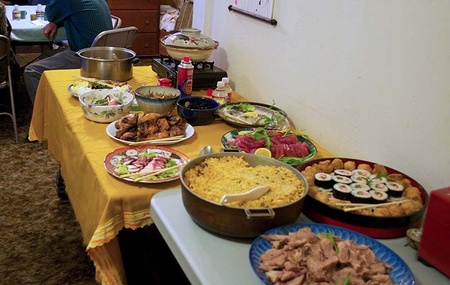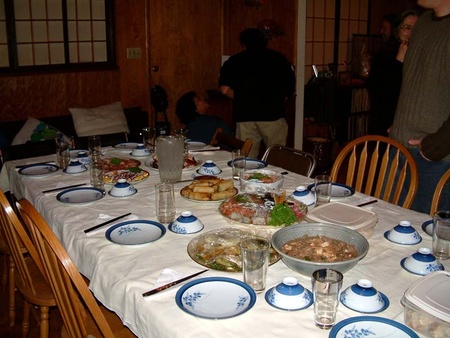1.
The comment on my blog begins, “I have found you and your sister at last.” The commenter describes herself as a childhood/young-adulthood friend of my dad’s. As far as I know, we’ve never met. But she knows my sister’s and my name, two fairly unusual names even in Japanese America. She knows that I grew up in Roseville, California. She says that she has memories of my father that she wants to share with me.
I’m slightly creeped out at first. I run through my mental Rolodex of names from my childhood: so many guests crowded into our little house for dinner parties. Nothing. Who is she?
But it’s the postscript to the woman’s comment that clinches it for me.
“I even know the secret to your dad’s sukiyaki recipe (learned from your grandfather): Log Cabin syrup!”
Bingo. She’s for real.
2.
I could call sukiyaki a “one-pot dish” (nabemono, in Japanese), but that doesn’t capture sukiyaki very well for the uninitiated. The seeming simplicity of the “one pot” is really “one pot plus several platters,” since it requires a lot of chopping and pre-assembled ingredients and sauces. Sukiyaki is almost a stir-fry with a lot of sauce: beef, plus tofu, green onions, shirataki (yam) noodles, red onions, and bamboo shoots.
Sukiyaki to me means platters and platters of red flank steak, sliced thinly. It means the piercing scent of red onions, enough to make you cry. But as with some of the best recipes, the secret’s in the sauce. Most sukiyaki recipes that I’ve seen are soy-sauce based, perhaps with some mirin added in for sweetness. Some methods call for serving it with raw egg on the side, where every bite is dipped.
Our sukiyaki sauce is luscious. A blend of soy sauce and miso, with raw eggs hidden in the sauce to add body, and umami kicked up several notches using a couple of jiggers of sake and the liquid from canned straw mushrooms, all balanced by a little sweetness (remember the Log Cabin syrup). All of that sits overnight to help the flavors meld.
I love that our family recipe has Log Cabin syrup, though for a while during the High Fructose Corn Syrup Scare, I stopped using it and substituted maple syrup instead. But I love that the recipe calls for Log Cabin specifically. It’s the quintessential American frontier home in my quintessential Japanese American food.
Food in my family is home. Other families rent cabins and wear T-shirts for their family reunions. My family cooks. We do it every year on New Year’s Day (Oshogatsu), and we have done this for over sixty years. It’s my touchstone, my annual miracle.
Now, I’ve never thought of myself as a particularly traditional Japanese American (or Filipina American, for that matter). I moved away from home to go to college and graduate school. I kept my last name when I got married. I married a man who will carry my purse in public, wear tiaras at his daughters’ demand, and mend his own pants. But when I felt old enough to graduate from “the kids’ table” (operative word: “felt”), I started to cook sukiyaki for New Year’s. I’ve wondered about why I make it: why it means so much when one of my aunties says, “The sukiyaki was good this year.” Tradition is only part of the answer.
3.
The truth is that I cook sukiyaki to bring my dad back to the family table.
He died relatively young. He was fifty two and I was ten. It’s a wound so painful that I’ve only recently thought about how to look at the scars, some twenty-five years later. The family that gathers each New Year is my dad’s: his five siblings and their sons and daughters. We don’t talk about my dad very often at New Year’s. I don’t think that we try to avoid his memory; he died quite some time ago, after all. But we don’t talk about him very much.
My dad was a middle child, a friend who threw lavish dinner parties that doubled as personal cooking shows, an uncle who played Scrabble and chess ferociously, a husband who made sure that his young daughters celebrated their mother with not just one, but several Mother’s Day cards. Some would say that just by coming to New Year’s, my sister and I bring our dad back to the table.
But in my family—one that often speaks its community less with words, and more with gathering and food—sukiyaki is both conversation and communion, a way to honor the beloved living and our beloved dead.
*Karaoke fans may think of Kyu Sakamoto’s hit Ue o muite (1961), better known as “The Sukiyaki Song.” But the song’s title and lyrics have no relation to the dish. No karaoke songs were harmed in the making of this dish.
* This article originally appeared in Remedy Quarterly issue 7, Heritage.
* * * * *
Our Editorial Committee Selected this article as one of their favorite Itadakimasu! stories. Here are the comments.
Comment from Nina Kahori Fallenbaum:
There has never been a “quintessential Nikkei experience,” nor does there need to be. But Tamiko Nimura gets pretty close. Her essay sings with descriptions of her family’s favorite Log Cabin Sukiyaki. I can almost taste the sauce she so lovingly describes, with its surprising addition of a North American original, maple syrup.
Yet her story is universal, too. Anyone who has lost a relative can relate to her affection and curiosity, or the responsibility of “graduating from the kid’s table” to carry on parts of one’s family legacy. For her family, that meant sukiyaki sauce.
I hope her essay will inspire Nikkei all around the world to hang on to precious recipes while constantly inventing new ones. Each one tells a story.
Comment from Nancy Matsumoto:
There are so many things I liked about this beautifully written essay. The use of Log Cabin maple syrup as a sweetener for sukiyaki is a terrific example of Issei ingenuity. I love the image of “the quintessential American frontier home” being subverted and turned into the “quintessential Japanese American food,” just as so many Issei and Nisei quietly claimed their right to be both American and Japanese during World War II. The description of the writer’s family as “one that often speaks its community less with words and more with gathering and food,” and the act of making a favorite dish in part to bring the memory of a loved one back to the table are things many Nikkei can relate to as well.
© 2012 Tamiko Nimura








